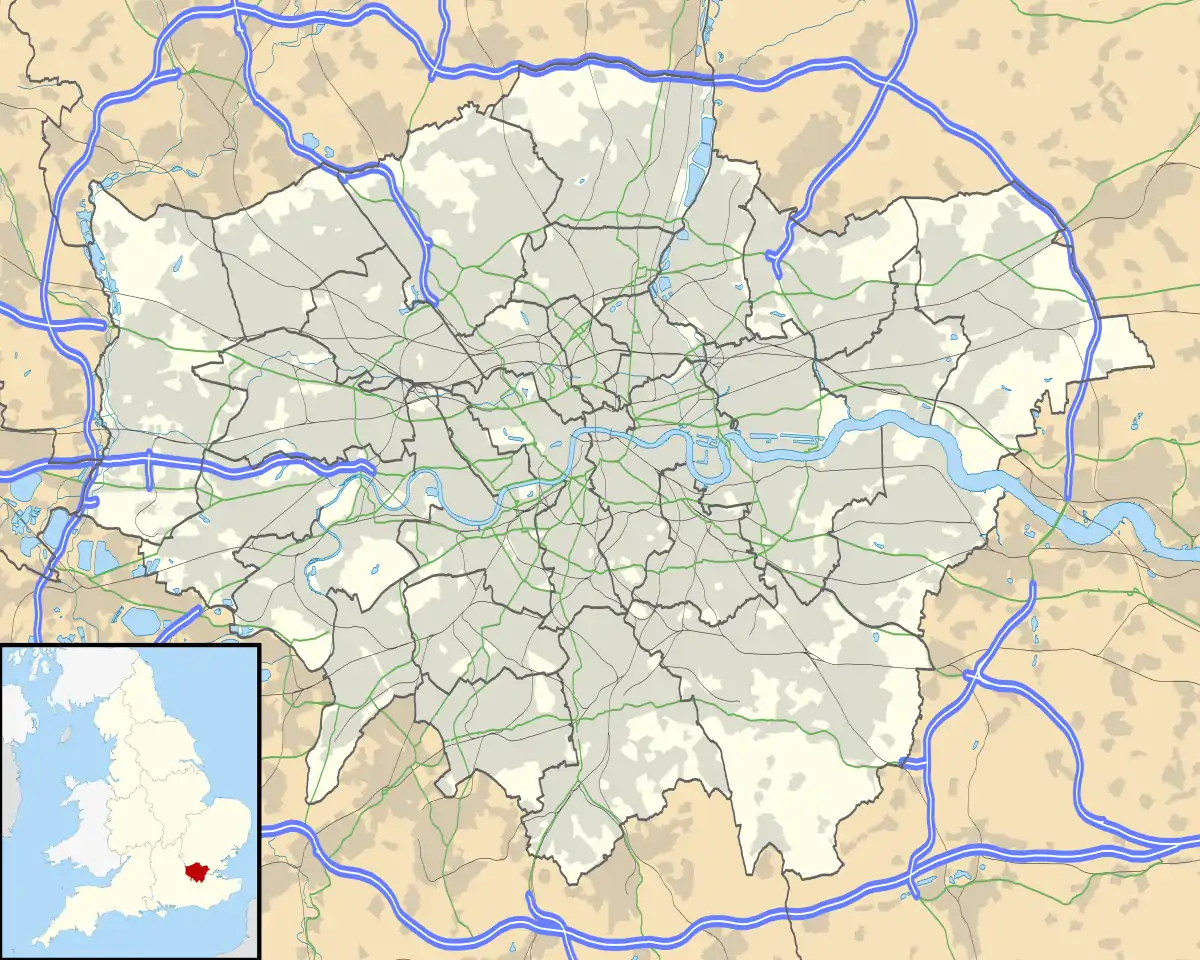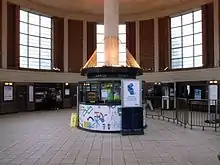Arnos Grove tube station
Arnos Grove is a London Underground station located in Arnos Grove in the London Borough of Enfield, London. It is on the Piccadilly line between Bounds Green and Southgate stations and is in Travelcard Zone 4.[6] The station opened on 19 September 1932 as the most northerly station on the first section of the Piccadilly line extension from Finsbury Park to Cockfosters. It was the terminus of the line until services were further extended to Oakwood on 13 March 1933. When travelling from east of Barons Court and through Central London, Arnos Grove is the first surface station after the long tunnel section of the Piccadilly line. The station has four platforms which face three tracks.
| Arnos Grove | |
|---|---|
.jpg.webp) Station entrance | |
 Arnos Grove Location of Arnos Grove in Greater London | |
| Location | Arnos Grove[1] |
| Local authority | London Borough of Enfield |
| Managed by | London Underground |
| Number of platforms | 4 (facing 3 tracks) |
| Fare zone | 4 |
| London Underground annual entry and exit | |
| 2015 | |
| 2016 | |
| 2017 | |
| 2018 | |
| 2019 | |
| Railway companies | |
| Original company | London Electric Railway |
| Key dates | |
| 19 September 1932 | Station opened as terminus |
| 13 March 1933 | Line extended to Enfield West (now Oakwood) |
| Listed status | |
| Listing grade | II* (since 20 July 2011) |
| Entry number | 1358981[5] |
| Added to list | 19 February 1971 |
| Other information | |
| External links | |
| WGS84 | 51.6163222°N 0.1335361°W |
The station was designed by architect Charles Holden, and has been described as a significant work of modern architecture. On 19 February 1971, the station was Grade II listed. In 2005, the station was refurbished with the heritage features also maintained. In July 2011 Arnos Grove's listed status was upgraded to Grade II*.[7] The station was awarded with the Best Newcomer and the Best Overall Garden in the Underground in Bloom 2011 competition and also in the London in Bloom competition.
Location
The station is located on A1110 Bowes Road, serving a medium-sized residential area. Arnos Grove is the first surface station after the long tunnel section which starts east of Barons Court and passes through Central London.[8] The station and surrounding neighbourhood of Arnos Grove take their names from the Arnos Grove estate, which was to the north of the station.[1] The station is part of the Arnos Grove group of stations, comprising all seven stations from Cockfosters to Turnpike Lane, and the management office for the group is in Arnos Grove station. Linked to the station by a lineside passageway is Ash House, which is a drivers' depot. Nearby attractions include Arnos Park, Broomfield School and Bowes Road Library.[9] Arnos Grove is known for its circular ticket hall and as a quiet, peaceful and green neighbourhood until the 1960s. When the Piccadilly line extension came, Edwardian villas were built in the area.[10]
History
The Great Northern railway (GNR) and its successor, the London and North Eastern Railway (LNER), for many years refused consent for any extension into the suburbs of Haringey and Enfield. In 1902, parliamentary approval was obtained to ban any further extensions of London Underground lines northwards from Finsbury Park. This created a bottleneck at Finsbury Park, back then the northern terminus of the Piccadilly line.[note 1] By 1923, a public campaign against the 1902 parliamentary ban emerged, and Frank Pick had risen to Assistant Managing Director of the Underground group. To help address this issue, Frank Pick gathered photographs of the congestion at Finsbury Park and distributed to the press. In 1925, the LNER gave in to the objection. Pick began working on the extension proposal and obtained parliamentary approval in 1929. The alignment was based on the absence of property development along the line. Funding was obtained from legislation under the Development (Loan Guarantees and Grants) Act instead of the Trade Facilities Act. Tunnel rings, cabling and concrete was produced in Northern England, while unemployed industrial workers there helped in the construction of the extension.[11] 22 tunnelling shields were used during construction which started in 1930. The station was opened on 19 September 1932 as the terminus on the first section of the Piccadilly line extension to Cockfosters. The line was further extended to Oakwood on 13 March 1933.[8] Its name was chosen after public deliberation: alternatives were "Arnos Park", "Bowes Road" and "Southgate".[12]
Incidents
On the night of 13 October 1940, during the Blitz, a lone German aircraft dropped a single bomb on houses to the north of Bounds Green station. The destruction of the houses caused the north end of the westbound platform tunnel to collapse.[13] As a result, train services between Wood Green and Cockfosters were disrupted for two months. On 11 August 1948, a passenger train was derailed when the front and rear bogies of a carriage took different routes at a set of points at the station.[14] On 7 July 2005, a bomb exploded on a train travelling between King's Cross St. Pancras and Russell Square. Train services between Hyde Park Corner and Arnos Grove were disrupted until 4 August of the same year.[8]
Station building
Like the other stations Charles Holden designed for the extension, Arnos Grove was built in a modern European style using brick, glass and reinforced concrete and basic geometric shapes.[5] A circular drum-like ticket hall of brick and glass panels rises from a low single-storey structure and is capped by a flat concrete slab roof.[5] The design was inspired by the Stockholm City Library and Swedish architect Gunnar Asplund.[15][note 2] The centre of the ticket hall is occupied by a disused ticket office (a passimeter in London Underground parlance)[17] which houses an exhibition on the station and the line.
The station today

Three parallel train tracks pass through the station, with two double-sided platforms between the central track and the outer tracks.[8] The edges of the platforms are labelled platform 1 and 2, and platform 3 and 4, in such a way that the two outer tracks are accessible from platforms 1 and 4, and the central track, usually used by trains that terminate and reverse at Arnos Grove station, is accessible from platforms 2 and 3.[8] Platforms 1 and 2 are designated for trains to Cockfosters while platforms 3 and 4 are for trains to Central London.[8]
In July 2011 Arnos Grove became a Grade II* listed building.[18] The building is one of the 12 "Great Modern Buildings" profiled in The Guardian during October 2007.[19][note 3] Arnos Grove Drivers' Depot won Best Newcomer and Best Overall Garden in the Underground in Bloom 2011 competition[20] for their new project which also got them an award in the London in Bloom competition. Their website[21] tells the whole story with photographs of the garden and the awards ceremonies.
Station improvements
In 2005 the station underwent a refurbishment programme[22] including improvements to signage, security and train information systems. General repairs and redecoration were carried out, flooring was renewed, and better lighting, an improved CCTV security system and Help Points were installed, with the latter being suitable for people with limited hearing. Some of the original signs are in a 'petit-serif' adaptation of the London Underground typeface, Johnston Delf Smith Sans.[17] This typeface was designed by Charles Holden and Percy Delf Smith, a former pupil of Edward Johnston.[23]
During the refurbishment programme, all these heritage features were maintained as well:[17]
- The circular 'Sudbury box' red brick building with overhanging crenellated concrete roof and vestibule to front and left-hand elevations
- Dark red brick walls extending to either side of building and also on bridge parapet wall and also on the other side of Bowes Road
- Bronze-framed silhouette roundels with reinstated 1930s graphics on concrete backing panels on brick walls at either end of bus slip road
- Flag pole mounted silhouette roundel with reinstated 1930s graphics on vestibule roof
- Full height windows
Services and connections

Services
A journey between Arnos Grove and Southgate typically takes slightly more than four minutes.[24] Train frequencies vary throughout the day, but generally operate every 3–9 minutes between 07:07 and 01:07 eastbound,[25] and every 2–6 minutes between 05:19 and 00:06 westbound.[26] When operational problems occur on the line, Arnos Grove station may act as a temporary terminus of a reduced service – either a shuttle service between Arnos Grove and Cockfosters or a truncated service from Central London.[8] The station has a set of seven sidings to its south for stabling trains.[9][27]
| Preceding station | Following station | |||
|---|---|---|---|---|
| Piccadilly line | towards Cockfosters |
|||
| Terminus |
Connections
- London Bus routes 34, 184, 232, 251, 298 and 382 and night route N91 serve the station.[28]
- New Southgate railway station is a ten-minute walk from Arnos Grove.[29]
Nearby places
In popular culture
- The station building appears as "Marble Hill" tube station[30] in the episode "Wasps' Nest" of the Agatha Christie's Poirot TV series with David Suchet as Hercule Poirot.[31]
- The station also appears in two films, Faolan Jones' drama The Chase (2013) and the 1999 remake of The End of the Affair starring Ralph Fiennes and Julianne Moore.
- Arnos Grove is often noted for its station cat (a rarity on the London Underground network), called Spooky, who occupies the station car park after being evicted in 2014 due to the introduction of UTS gates.[32]
Notes and references
Notes
- Passengers heading to places north of Finsbury Park such as Arnos Grove had to change to buses, trams or change onto Great Northern trains.
- A similar design was employed by Holden for the rebuilding of Chiswick Park on the District line (also in 1932), although the drum there is supplemented with an adjacent brick tower.[16]
- It was summarised by architectural critic Jonathan Glancey as "...truly what German art historians would describe as a gesamtkunstwerk, a total and entire work of art."[15]
References
- "Arnos Grove, Enfield". London Gazetteer. Hidden London. Archived from the original on 8 May 2015.
- "Multi-year station entry-and-exit figures (2007–2017)" (XLSX). London Underground station passenger usage data. Transport for London. January 2018. Retrieved 22 July 2018.
- "Station Usage Data" (CSV). Usage Statistics for London Stations, 2018. Transport for London. 21 August 2019. Retrieved 27 April 2020.
- "Station Usage Data" (XLSX). Usage Statistics for London Stations, 2019. Transport for London. 23 September 2020. Retrieved 9 November 2020.
- Historic England. "Arnos Grove Underground Station (1358981)". National Heritage List for England. Retrieved 12 November 2012.
- Standard Tube Map (PDF) (Map). Not to scale. Transport for London. May 2020. Archived (PDF) from the original on 16 January 2021. Retrieved 16 January 2021.
- "Sixteen London tube stations become listed buildings – GOV.UK". www.gov.uk. Retrieved 2 February 2018.
- Feather, Clive. "Piccadilly line". Clive's Underground Line Guides. Archived from the original on 9 May 2015.
- "Arnos Grove tube station". Google Maps. Retrieved 9 May 2015.
- Martin 2012, p. 183.
- Martin 2012, pp. 182–183.
- Dumayne, Alan (1998). Southgate. Sutton Publishing Limited. p. 44. ISBN 0-7509-2000-9.
- Richard, McKeever (7 September 2010). "Bounds Green and the Blitz". Bowes and Bounds Connected. Archived from the original on 9 May 2015. Retrieved 9 May 2015.
- Earnshaw, Alan (1993). Trains in Trouble: Vol. 8. Penryn: Atlantic Books. p. 22. ISBN 0-906899-52-4.
- Jonathan, Glancey (16 October 2007). "Great modern buildings: Going Underground". Architecture. The Guardian. Archived from the original on 9 February 2015. Retrieved 25 January 2009.
- Historic England. "Chiswick Park Underground Station (including two platforms with canopies and shelters and shops to either side of ticket hall) (1358798)". National Heritage List for England. Retrieved 13 May 2015.
- "Arnos Grove improved". Transport for London. 25 February 2005. Archived from the original on 10 May 2015. Retrieved 10 May 2015.
- "16 London Underground Stations Listed at Grade II". English Heritage. Archived from the original on 14 September 2011.
- "No 9: Arnos Grove station". The Guardian's Great Modern Buildings Series. The Guardian. Archived from the original on 15 June 2008. Retrieved 21 November 2007.
- Lindsey, Clarke (9 September 2011). "Underground In Bloom 2011 Winners Announced". londonist. Archived from the original on 6 June 2012.
- "arnos grow'n'picc club". Archived from the original on 2 April 2012.
- "Station Refurbishment Summary" (PDF). London Underground Railway Society. July 2007. Archived (PDF) from the original on 10 May 2015. Retrieved 10 May 2015.
- John, Bull (18 September 2009). "A Typeface for the Underground". London Reconnections. Archived from the original on 29 January 2015. Retrieved 10 May 2015.
- "Stations that it takes the longest to travel between". Tube Facts and Figures. Geofftech. Archived from the original on 1 May 2015. Retrieved 13 May 2015.
- "Piccadilly line timetable: From Arnos Grove Underground Station to Southgate Underground Station". Transport for London. Retrieved 13 May 2015.
- "Piccadilly line timetable: From Arnos Grove Underground Station to Bounds Green Underground Station". Transport for London. Retrieved 13 May 2015.
- Jarrier, Franklin. "Greater London Transport Tracks Map" (PDF) (Map). CartoMetro London Edition. 3.7. Archived (PDF) from the original on 18 November 2018.
- "Buses from Arnos Grove and New Southgate" (PDF). Transport for London. March 2015. Archived from the original (PDF) on 29 June 2015. Retrieved 29 June 2015.
- "From Arnos Grove Tube Station to New Southgate Railway Station". Google Maps — Directions. Retrieved 13 May 2015.
- "Wasps' Nest". Agatha Christie: Poirot. IMDb. 1991. Archived from the original on 12 May 2015. Retrieved 12 May 2015.
- David, Renwick; Brian, Farnham; Agatha, Christie (27 January 1991). "Wasps' Nest". Season 3. Episode 5. London, UK. 50 minutes in. Archived from the original on 13 May 2015. Retrieved 13 May 2015.
- "Arnos Grove". Platform for art – Thin Cities. Transport for London. Archived from the original on 2 February 2014.
Bibliography
- Martin, Andrew (2012). Underground, Overground: A Passenger's History of the Tube. Profile Books. ISBN 978-1-84765-807-4.
External links
| Wikimedia Commons has media related to Arnos Grove tube station. |
- "Arnos Grove". Photographic Archive. London Transport Museum. Archived from the original on 26 January 2014.
- "Plan and elevation of station". drawings. Royal Institute of British Architects. 1931. Archived from the original on 7 July 2011.
- "Early image of Arnos Grove tube station". CharlesHolden.com. Archived from the original on 23 November 2003.
- "History of Arnos Grove and Southgate". Borough of Enfield. Archived from the original on 26 May 2005.
- "Great Modern Buildings Series". The Guardian. Archived from the original on 21 November 2007.
- "Arnos Grove 3D model for Google Earth". Google Sketchup. Archived from the original on 2 April 2015. Retrieved 13 May 2015.
- "Garden created by green-fingered drivers". arnos grow'n'picc club. Archived from the original on 2 April 2012.